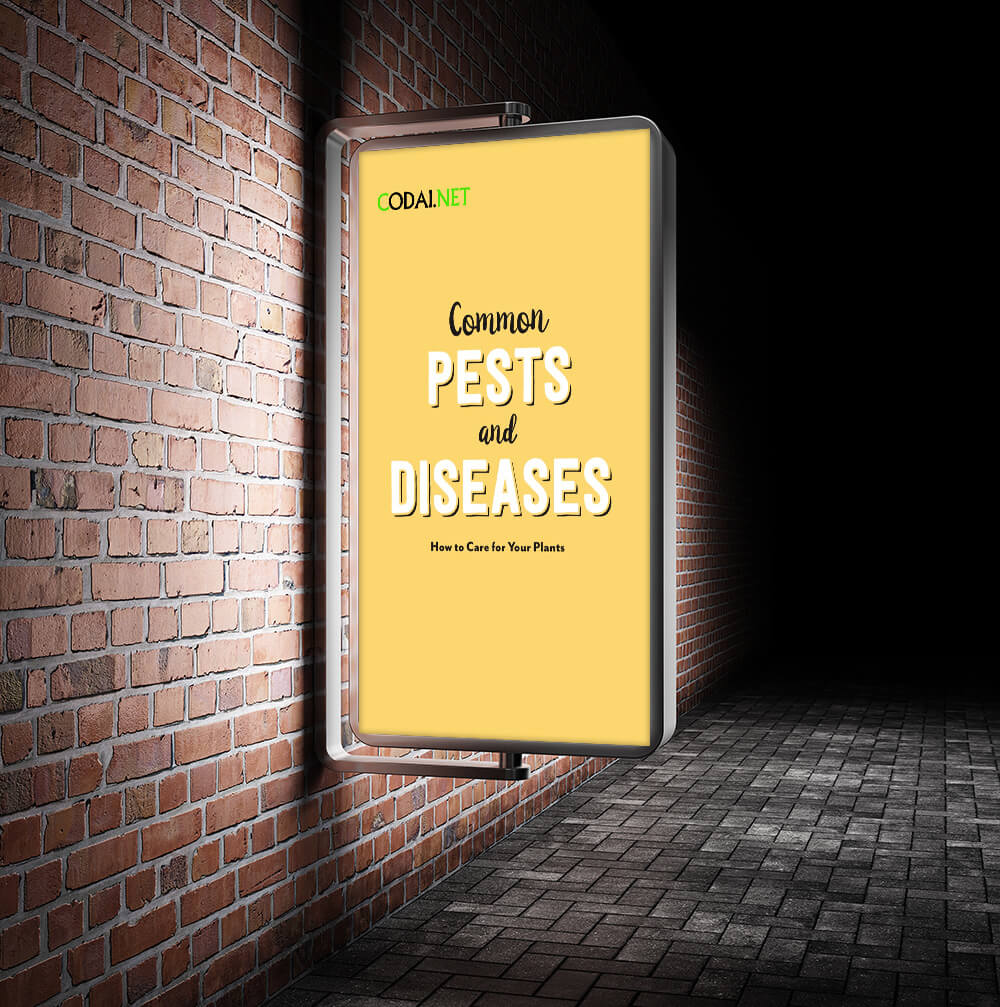Ebook Việt Hoá] Plant parenting: Easy ways to make more houseplants vegetables and flowers - LESLIE F. HALLECK
[Ebook Việt Hoá] Plant parenting – LESLIE F. HALLECK (Nhân giống cây) – COMMON PESTS AND DISEASES (Các loại côn trùng và bệnh thường gặp)
- Nguồn: [Ebook Việt Hoá] Plant parenting: Easy ways to make more houseplants, vegetables, and flowers – LESLIE F. HALLECK (Nhân giống cây: Những cách dễ nhất để nhân giống cây cảnh trong nhà, rau và hoa)
- Biên tập: Dũng Cá Xinh (Tháng 08/20201)
- Dịch: Huyền Nguyễn
English
Once your seedlings emerge and begin developing new leaves, or you begin potting them up into larger containers, different pests or diseases can often crop up. It’s also easy to unwittingly introduce a pest or disease when you bring outdoor plants inside for the winter or buy new plants for your indoor garden. These hitchhikers can quickly find a home and reproduce on your young seedlings and cuttings. You can also accidentally perpetuate a disease or pest problem if you take cuttings from an infested or infected mother plant. If you’re keeping houseplants indoors, several pesky pests can become a recurring nuisance.
Even experienced plant growers will have issues with insects and diseases, especially when growing indoors. As previously discussed (see page 113), seeds that are germinating can succumb to damping off disease. But as seedlings grow, new predators can move in. For example, my pepper plant seedlings and mature plants often end up with aphids when I grow them indoors—even if the plants are well cared for and healthy. Outdoors, on the other hand, you’ll rarely have a problem with aphids on peppers. The indoor conditions are more favorable for an aphid explosion.
If you grow your houseplants in soil with some organic matter, you will probably always have some fungus gnats, off and on. If you grow certain kinds of plants that are particularly susceptible to certain pests, such as citrus (spider mites, scale, and mealy bugs), you’re bound to see these pests crop up from time to time.
Don’t get discouraged. Just watch out for early signs of problems so you can keep them at bay. If you lose some plants to a pest or disease issue, it’s no biggie—that’s why you have this book—you can make many more!
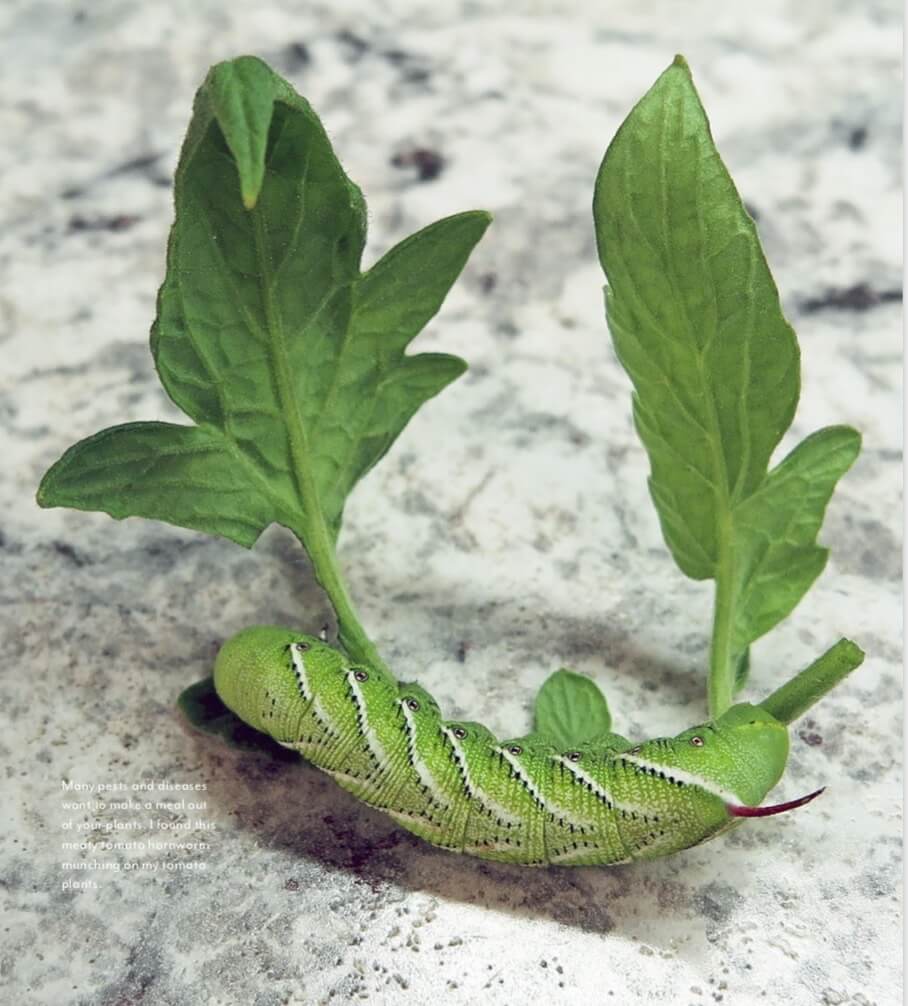
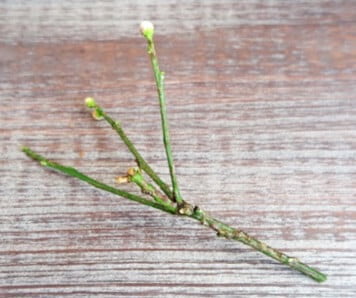
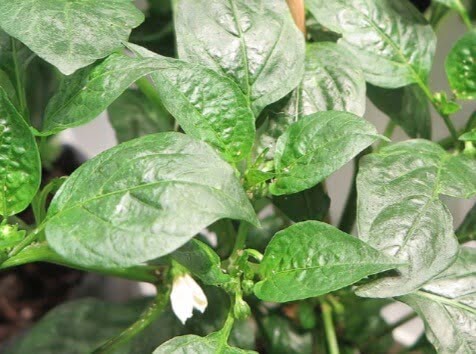
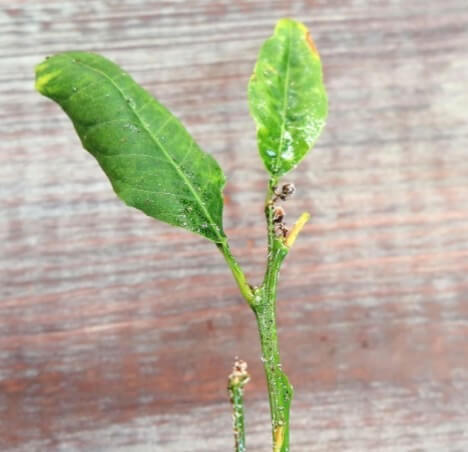
Common Pests on Plants
| PEST | DESCRIPTION | TARGET PLANTS | SIGNS/SYMPTOMS | TREATMENT |
| Aphids | Small, oval shaped, green, black, or white. Aphids suck water and nutrients from leaves and stems. They also carry viruses they pass from plant to plant as they feed. | Annual flowers, beans, beets, bok choy, cannabis, chard, citrus, cucumber, fruit trees, herbs, lettuce, peppers, perennials, and roses. | Curled or wilted foliage, stunted growth. General decline. Affected plants become more suscep- tible to other pests and diseases. | Insecticidal soap, horticul- tural oils, spinosad. Wash off leaves and stems with spray of water, or manual removal (squish them!). |
| Fungus gnats | Tiny black gnats that fly around the potted plant. Small white larvae in the soil. | Any potted plants grow- ing indoors in potting soil that contains organic matter. | Larvae feed on the plant roots in the soil. Gnats flying about the plants and room. General plant decline. | Boost air circulation with fans. Reduce overwatering. Sticky traps. 10% hydrogen peroxide soil drench, Bt granules. |
| Mealy bugs | Soft-bodied, wingless, fuzzy cottony masses, some with long tails. On leaves, stems, and bark. They jump! | Cannabis, citrus, many foliage houseplants, gar- denia, and succulents. | Yellowing and curling of leaves. Sticky honeydew residue. | Wash off, manual removal (squish!). Insecticidal soap, horticultural oils, spinosad. Systemic insecticide. Pred- atory insects. Move plants outside. |
| Scale | Oval-shaped insects with either a hard or cottony shell, with different colors. Cluster on stems and base of leaves. | Avocado, basil, citrus, many foliage house- plants, and succulents. | Stunted growth. Weak appearance, shriveled and yellow leaves that often drop off. Sticky honeydew residue. Fungus can grow on honeydew. | Wash off, manual removal. Insecticidal soap, horticultur- al oils, spinosad. Predatory insects. Systemic insecticide. Difficult to treat because of hard outer shell. Move plants outside. |
| Spider mites | Fast-moving, tiny arachnids with red-brown or pale col- oring. Underside of leaves and stems. Fine webbing on leaves. | Annual flowers, basil, berries, cannabis, citrus, English ivy, foliage plants, herbs, perennials, roses, shrubs, tomatoes, and tropicals. | Pale or yellow mottled cast to leaves, leaf curling and dropping. Tiny pinprick holes on leaves. | Insecticidal soap, horticultur- al oils, spinosad. Predatory insects. Miticide. Persistent and require multiple treat- ments. Move plants outside. |
| White- flies | Tiny white flies on leaves and stems. If you shake the plant, they will fly around the plant. Larvae and nymphs suck plant sap. | Cannabis, citrus, cucum- ber, many foliage house- plants, grapes, potatoes, squash, strawberries, tomatoes, and tropicals. | Mottled leaf appearance, yellowing and dropping leaves, overall reduced growth and vigor. Sticky honeydew followed by sooty mold. | Sticky traps, insecticidal soap, horticultural oils, spi- nosad. Persistent and require repeat treatments. Move plants outside. |
Common Plant Diseases
| DISEASE | DESCRIPTION | TARGET PLANTS | SIGNS/SYMPTOMS | TREATMENT |
| Bacterial stem rot (Erwinia) | A bacterial disease that enters plant tissue through wounds in stems and leaves. | African violets, annual flowers, carrots, egg- plant, foliage plants, peppers, philodendron, potatoes, tomatoes, and more. | One or two branches wilt first, with water-soaked black lesions on stems. The rest of the plant may then wilt and die. | No effective chemical control. Use clean cuttings and tools; keep workspace clean. Remove infected plants immediately. Avoid plant injury. |
| Early blight (Alternaria) | A leaf spot fungus spread by splashing rain, irriga- tion, insects, and garden tools. Common in humid, warm conditions. | Eggplant, peppers, po- tatoes, and tomatoes. | Lower leaves develop small brown spots. Spots spread, turning the leaf yellow, which then curls and drops. | No overhead irrigation or misting. Water at the soil level. Remove infected leaves immediately and improve air circulation. Foliar fungicide. |
| Damping off and root rot (Pythium, Rhizoctonia) | Damping off: Fungal pathogens that rot seed- lings right at or just below the soil line.
Root rot: Many pathogens that attack root systems, turning them brown. |
All seedlings and young transplants. Any plants growing in waterlogged soils can suffer from root rot. Can be an issue in hydroponic systems. |
Seedlings fall over at the soil line before they can mature. Plants begin to droop, wilt, turn brown, and collapse. Root tissue is brown and can be slimy. | Don’t overwater seedlings or keep humidity too high. Use a sterile soil mix and manage soil temperature. Improve soil drainage and aeration. Oxygenate hydrosystems. Add benefi- cial bacteria. |
| Gray mold (Botrytis) | A mold disease that grows on leaf surfaces, blocking light from the leaf surface and causing severe dam- age to foliage and flowers. | African violets, berries, cannabis, carrots, flow- ering annuals, foliage plants, bulbs, grapes, peas, roses, tomatoes, and many more. | White spots on leaves or stems that turn gray, then brown. The fungus can cover large areas or the entire plant with webbing. | Good soil drainage. Improve air circulation between plants. Remove infected leaves and blooms. Foliar fungicide. |
| Powdery mildew (Podosphaera) | A fungal disease with fuzzy white growth. Spreads quickly, covering foliage and blocking photosynthesis. | Annual flowers, beans, cannabis, citrus, cu- cumbers, foliage plants, herbs, roses, peas, pep- pers, squash, tomatoes, and many more. | Powdery white substance on foliage. Reduced overall growth and vigor, stunted yellowing leaves that drop. | No overhead irrigation or misting. Control humidity levels. Water at the soil level. Foliar fungicide. |
| Sooty mold (Alternaria, Cladosporium) | Several types of fungal spe- cies. A gray- to black-col- ored mold that grows on the honeydew residue produced by aphids, scale, and whiteflies. | Any plant susceptible to aphids, scale, and whiteflies. Annual flowers, citrus, herbs, and perennials. | Mold spreads across the leaf surface, blocking light and photosynthesis. Leaves yellow and drop. Overall reduced growth and vigor. | Wipe off plant leaves with soapy water, a plant wash product, or neem oil. Control aphids, scale, and whiteflies. |
Tiếng Việt
Khi cây con mọc lên và bắt đầu phát triển các lá mới, hoặc bạn bắt đầu trồng chúng vào các thùng chứa lớn hơn, các loại sâu bệnh khác nhau thường có thể phát sinh. Bạn cũng có thể vô tình tạo ra sâu bệnh khi mang cây trồng ngoài trời vào trong nhà vào mùa đông hoặc mua cây mới. Những loại sâu hại gây bệnh này có thể nhanh chóng trú ẩn và sinh sản trên cây con và cành giâm. Bạn cũng có thể vô tình gây ra tình trạng bệnh hoặc sâu bệnh ở cây nếu lấy cành giâm từ cây mẹ bị nhiễm bệnh. Nếu bạn đang trồng cây cảnh trong nhà, một số loài gây hại khó chịu có thể thường xuyên trở thành mối phiền toái.
Ngay cả những người trồng cây có kinh nghiệm cũng sẽ gặp vấn đề về côn trùng và bệnh tật, đặc biệt là khi trồng cây trong nhà. Như đã thảo luận trước đây (xem trang 113), hạt giống đang nảy mầm có thể chống lại bệnh tật. Nhưng khi cây con lớn lên, những loài sâu bệnh mới có thể di chuyển đến. Ví dụ, cây Tiêu và cây trưởng thành thường bị rệp khi tôi trồng trong nhà, ngay cả khi cây được chăm sóc tốt và khỏe mạnh. Mặt khác, ở ngoài trời, loài cây này sẽ hiếm khi gặp vấn đề về rệp. Các điều kiện trong nhà thuận lợi hơn cho sự sinh sôi của rệp.
Nếu bạn trồng cây trong nhà bằng đất có một số chất hữu cơ, cây của bạn có thể sẽ luôn bị nấm gặm nhấm. Nếu bạn trồng một số loại cây đặc biệt nhạy cảm với một số loại sâu bệnh, chẳng hạn như nếu bạn trồng Cam Quýt, thỉnh thoảng bạn nhất định sẽ thấy những loài gây hại như nhện, bọ vảy và rệp sáp xuất hiện.
Tuy nhiên, bạn đừng nản lòng. Chỉ cần để ý những dấu hiệu ban đầu của vấn đề để có thể giúp bạn ngăn chặn bệnh. Nếu bạn bị mất một số cây trồng do sâu bệnh hại thì cũng không có vấn đề gì, đó là lý do tại sao bạn cầm trên tay cuốn sách này!




Sâu hại thường gặp trên cây trồng
| LOẠI SÂU |
MÔ TẢ |
CÂY TRỒNG |
DẤU HIỆU |
ĐIỀU TRỊ |
| Rệp | Kích thước nhỏ, hình bầu dục, màu xanh lục, đen hoặc trắng. Rệp hút nước và chất dinh dưỡng từ lá và thân. Chúng cũng mang vi rút truyền từ cây này sang cây khác. | Hoa hàng năm, Đậu, củ Cải Đường, Cải Chíp, Cần Sa, Cải Thìa, Cam Quýt, Dưa Chuột, cây ăn quả, rau thơm, rau Diếp, Tiêu, cây lâu năm và hoa Hồng. | Tán lá cong hoặc héo, sinh trưởng còi cọc. Suy giảm chung. Các cây bị ảnh hưởng trở nên nhạy cảm hơn với các loại sâu bệnh khác. |
Xà phòng diệt côn trùng, dầu hoa Lan, spinosad. Rửa sạch lá và thân cây bằng vòi xịt nước hoặc loại bỏ thủ công (vò rệp). |
| Nấm gặm nhấm | Những con nấm gặm nhấm đen nhỏ xíu bay xung quanh chậu cây. Ấu trùng nhỏ màu trắng trong đất. | Bất kỳ chậu cây nào phát triển trong nhà trong bầu đất có chứa chất hữu cơ. | Ấu trùng ăn rễ cây trong đất. Gặm nhấm cây cối. Sự suy giảm thực vật nói chung. |
Tăng cường lưu thông không khí bằng quạt. Sử dụng bẫy dính. 10% hydrogen peroxide đất hào, hạt Bt. |
| Rệp sáp | Loài thân mềm, không cánh, có các khối lông tơ mờ, một số có đuôi dài. Xuất hiện trên lá, thân và vỏ cây, và nhảy để di chuyển. | Cần Sa, Cam Quýt, cây trồng nhiều lá, hoa Dạ Yến Thảo, và các loài cây mọng nước. |
Úa vàng và quăn lá. Bã mật ong dính. | Rửa sạch, loại bỏ thủ công. Xà phòng diệt côn trùng, dầu làm vườn, spinosad. Thuốc trừ sâu toàn thân. Côn trùng ăn thịt. Chuyển cây trồng ra ngoài trời. |
| Vảy bắc | Côn trùng hình bầu dục có vỏ cứng hoặc bông, với các màu sắc khác nhau. Xuất hiện thành cụm trên thân và gốc lá. | Bơ, Húng Quế, Cam Quýt, cây nhiều lá, và các loài mọng nước. | Cây tăng trưởng còi cọc, tổng thể yếu ớt, lá héo và vàng thường rụng. Bã mật ong dính. Nấm có thể phát triển trên mật ong. | Rửa sạch, loại bỏ thủ công. Xà phòng diệt côn trùng, dầu làm vườn, spinosad. Côn trùng ăn thịt. Thuốc trừ sâu toàn thân. Khó xử lý vì lớp vỏ cứng bên ngoài. Chuyển cây trồng ra bên ngoài. |
| Ve nhện | Di chuyển nhanh, loài nhện nhỏ có màu nâu đỏ hoặc nhạt. Mặt dưới của lá và thân. Vải mịn trên lá. | Hoa hàng năm, Húng Quế, quả mọng, Cần Sa, Cam Quýt, cây Thường Xuân Anh, cây lấy lá, thảo mộc, cây lâu năm, hoa Hồng, cây bụi, Cà Chua và các loài nhiệt đới. | Lá xanh nhạt hoặc lốm đốm vàng, lá quăn lại và rụng. Những lỗ kim châm nhỏ trên lá. | Xà phòng diệt côn trùng, dầu làm vườn, spinosad. Côn trùng ăn thịt. Thuốc trừ sâu. Cần được điều trị bền bỉ và trong nhiều lần. Chuyển cây trồng ra bên ngoài. |
| Ruồi trắng | Những con ruồi trắng li ti trên lá và thân. Nếu bạn lắc cây, chúng sẽ bay xung quanh cây. Sâu non và nhộng hút nhựa cây. | Cần Sa, Cam Quýt, Dưa Chuột, cây lá nhiều cành, Nho, Khoai Tây, Bí, Dâu Tây, Cà Chua, và các loại cây nhiệt đới. | Xuất hiện các đốm lá, vàng và rụng lá, tổng thể sinh trưởng và sức sống của cây giảm. Mật ong dính, sau đó mốc meo. | Bẫy dính, xà phòng diệt côn trùng, dầu làm vườn. Cần điều trị kiên trì và lặp lại nhiều lần. Chuyển cây trồng ra bên ngoài. |
Bệnh thường gặp ở cây
| BỆNH | MÔ TẢ |
CÂY BỆNH |
DẤU HIỆU |
ĐIỀU TRỊ |
| Bệnh thối thân do vi khuẩn (Erwinia) | Bệnh do vi khuẩn xâm nhập vào mô thực vật qua vết thương ở thân và lá. | Hoa Violet châu Phi, hoa hàng năm, Cà Rốt, cây Trứng, cây lấy lá, Tiêu, Trầu Bà (philodendron), Khoai Tây, Cà Chua, v.v. | Một hoặc hai cành héo trước, trên thân có vết đen do ngấm nước. Phần còn lại của cây sau đó có thể héo và chết. | Phương pháp điều trị bằng hóa chất thường không hiệu quả. Sử dụng dụng cụ giâm cành sạch sẽ; giữ không gian làm việc sạch sẽ. Loại bỏ cây bị nhiễm bệnh ngay lập tức. Tránh làm cây bị hư hại. |
| Bệnh bạc lá sớm (Alternaria) | Nấm đốm lá lây lan do mưa tạt, nước tưới, côn trùng và dụng cụ làm vườn. Thường gặp trong điều kiện ẩm ướt, ấm áp. |
Cà Tím, Tiêu, Khoai Tây và Cà Chua. | Các lá phía dưới phát triển các đốm nhỏ màu nâu. Các đốm lan rộng, làm lá chuyển sang màu vàng, sau đó xoăn lại và rụng. | Không cần tưới hoặc phun sương cho cây. Tưới nước ở trên đất. Loại bỏ lá bị nhiễm bệnh ngay lập tức và cải thiện lưu thông không khí. Sử dụng thuốc trừ bệnh qua lá. |
| Chết cây và thối rễ (Pythium, Rhizoctonia) | Chết cây: Nấm bệnh làm thối hạt ngay dưới lớp đất.
Thối rễ: Nhiều mầm bệnh tấn công bộ rễ làm chúng chuyển sang màu nâu. |
Tất cả cây con và cây cấy non. Bất kỳ cây nào mọc trong đất úng nước đều có thể bị thối rễ. Đây có thể là một vấn đề trong hệ thống thủy canh. | Cây con rơi xuống đất trước khi chúng trưởng thành. Cây bắt đầu rũ xuống, héo úa, chuyển sang màu nâu và đổ. Mô rễ màu nâu và có thể nhầy. | Không tưới quá nhiều cho cây con hoặc giữ độ ẩm quá cao. Sử dụng hỗn hợp đất vô trùng và kiểm soát nhiệt độ đất. Cải thiện khả năng thoát nước và thông khí của đất. Bổ sung lợi khuẩn. |
| Mốc xám (Botrytis) | Một loại bệnh nấm mốc phát triển trên bề mặt lá, cản ánh sáng từ bề mặt lá và làm cho lá và hoa bị hư hỏng nặng. | Hoa Violet châu Phi, quả mọng, Cần Sa, Cà Rốt, cây hàng năm ra hoa, cây lấy lá, củ, nho, đậu Hà Lan, hoa Hồng, Cà Chua, và nhiều loại khác. | Các đốm trắng trên lá hoặc thân chuyển sang màu xám, sau đó chuyển sang màu nâu. Nấm có thể bao phủ các khu vực rộng lớn hoặc toàn bộ cây bằng dây vải. | Đất thoát nước tốt. Cải thiện lưu thông không khí giữa các cây. Loại bỏ các lá và hoa bị nhiễm bệnh. Sử dụng thuốc trừ bệnh qua lá. |
| Bệnh phấn trắng (Podosphaera) | Một bệnh nấm có màu trắng mờ phát triển. Phát tán nhanh chóng, che phủ tán lá và cản trở quá trình quang hợp. | Hoa hàng năm, Đậu, Cần Sa, Cam Quýt, cây Chùm Ngây, cây lấy lá, rau thơm, hoa Hồng, đậu Hà Lan, đậu Cô Ve, Bí, Cà Chua, và nhiều loại khác. | Chất trắng bột trên tán lá. Giảm khả năng sinh trưởng và sức sống tổng thể ở cây, các lá cây còi cọc, vàng úa và rụng. | Không cần tưới hoặc phun sương trên lá. Kiểm soát độ ẩm. Tưới nước ở mức đất. Sử dụng thuốc trừ bệnh qua lá. |
| Nấm mốc (Alternaria, Cladosporium) | Một số loại nấm đặc biệt. Một loại nấm mốc có màu từ xám đến đen phát triển trên tàn dư nấm mốc do rệp, vảy và ruồi trắng tạo ra. | Bất kỳ cây nào dễ bị rệp, vảy và ruồi trắng. Hoa hàng năm, Cam Quýt, thảo mộc và cây lâu năm. | Nấm mốc lan rộng trên bề mặt lá, cản trở ánh sáng và quá trình quang hợp. Lá vàng và rụng. Nhìn chung tốc độ tăng trưởng và sức sống ở cây giảm. | Lau sạch lá cây bằng nước xà phòng, sản phẩm rửa thực vật hoặc dầu neem. Kiểm soát rệp, vảy và ruồi trắng. |
